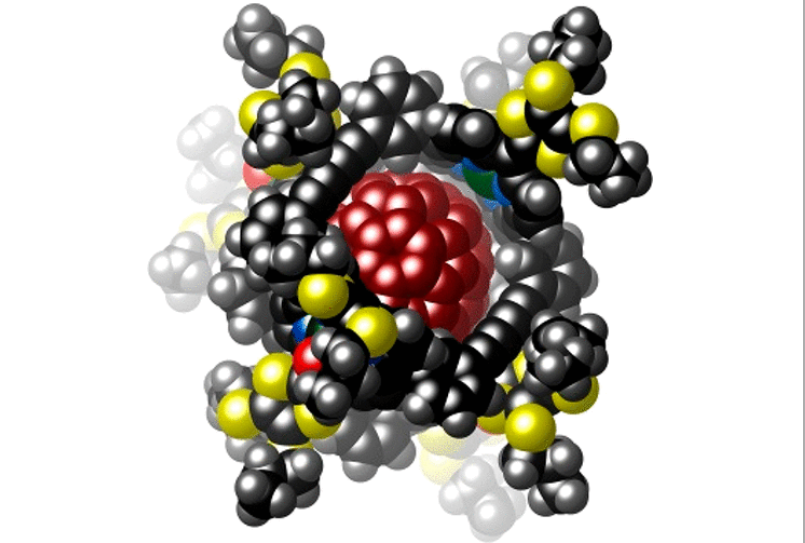Sen, S., Ishiwari, F., Kaur, R., Ishida, M., Ray, D., Kikuchi, K., Mori, T., Bähring, S., Lynch, V. M., Saeki, A., Guldi, D. M., Sessler, J. L., Jana, A., Journal of the American Chemical Society 2023, 145, 1031-1039. 10.1021/jacs.2c10555
We report here a nanosized “buckytrap”, 1, constructed from two bis-zinc(II) expanded-TTF (exTTF) porphyrin subunits. Two forms, 1a and 1b, differing in the axial ligands, H2O vs tetrahydrofuran (THF), were isolated and characterized. Discrete host–guest inclusion complexes are formed upon treatment with fullerenes as inferred from a single-crystal X-ray structural analyses of 1a with C70. The fullerene is found to be encapsulated within the inner pseudohexagonal cavity of 1a. In contrast, the corresponding free-base derivative (2) was found to form infinite ball-and-socket type supramolecular organic frameworks (3D-SOFs) with fullerenes, (2•C60)n or (2•C70)n. This difference is ascribed to the fact that in 1a and 1b the axial positions are blocked by a H2O or THF ligand. Emission spectroscopic studies supported a 1:1 host–guest binding stoichiometry, allowing association constants of (2.0 ± 0.5) × 104 M–1 and (4.3 ± 0.9) × 104 M–1 to be calculated for C60 and C70, respectively. Flash-photolysis time-resolved microwave conductivity (FP-TRMC) studies of solid films of the Zn-complex 1a revealed that the intrinsic charge carrier transport, i.e., pseudo-photoconductivity (ϕ∑μ), increases upon fullerene inclusion (e.g., ϕ∑μ = 1.53 × 10–4 cm2 V–1 s–1 for C60⊂(1a)2 and ϕ∑μ = 1.45 × 10–4 cm2 V–1 s–1 for C70⊂(1a)2 vs ϕ∑μ = 2.49 × 10–5 cm2 V–1 s–1 for 1a) at 298 K. These findings provide support for the notion that controlling the nature of self-assembly supramolecular constructs formed from exTTF-porphyrin dimers through metalation or choice of fullerene can be used to regulate key functional features, including photoconductivity.

Sen, S., Ishiwari, F., Kaur, R., Ishida, M., Ray, D., Kikuchi, K., Mori, T., Bähring, S., Lynch, V. M., Saeki, A., Guldi, D. M., Sessler, J. L., Jana, A., Journal of the American Chemical Society 2023, 145, 1031-1039. 10.1021/jacs.2c10555
We report here a nanosized “buckytrap”, 1, constructed from two bis-zinc(II) expanded-TTF (exTTF) porphyrin subunits. Two forms, 1a and 1b, differing in the axial ligands, H2O vs tetrahydrofuran (THF), were isolated and characterized. Discrete host–guest inclusion complexes are formed upon treatment with fullerenes as inferred from a single-crystal X-ray structural analyses of 1a with C70. The fullerene is found to be encapsulated within the inner pseudohexagonal cavity of 1a. In contrast, the corresponding free-base derivative (2) was found to form infinite ball-and-socket type supramolecular organic frameworks (3D-SOFs) with fullerenes, (2•C60)n or (2•C70)n. This difference is ascribed to the fact that in 1a and 1b the axial positions are blocked by a H2O or THF ligand. Emission spectroscopic studies supported a 1:1 host–guest binding stoichiometry, allowing association constants of (2.0 ± 0.5) × 104 M–1 and (4.3 ± 0.9) × 104 M–1 to be calculated for C60 and C70, respectively. Flash-photolysis time-resolved microwave conductivity (FP-TRMC) studies of solid films of the Zn-complex 1a revealed that the intrinsic charge carrier transport, i.e., pseudo-photoconductivity (ϕ∑μ), increases upon fullerene inclusion (e.g., ϕ∑μ = 1.53 × 10–4 cm2 V–1 s–1 for C60⊂(1a)2 and ϕ∑μ = 1.45 × 10–4 cm2 V–1 s–1 for C70⊂(1a)2 vs ϕ∑μ = 2.49 × 10–5 cm2 V–1 s–1 for 1a) at 298 K. These findings provide support for the notion that controlling the nature of self-assembly supramolecular constructs formed from exTTF-porphyrin dimers through metalation or choice of fullerene can be used to regulate key functional features, including photoconductivity.